Abstract
OBJECTIVE--To compare the outcomes in women with mild and moderate dyskaryosis after increasing periods of surveillance and thereby to define a rational protocol for managing such women. DESIGN--Prospective study with randomisation of women to one of four treatment groups, each with a different period of surveillance; one group in which the women were given immediate treatment and three other groups in which the women were under surveillance for six, 12, and 24 months. SETTING--A dedicated colposcopy clinic in Aberdeen, Scotland. SUBJECTS--902 women who presented with a mildly or moderately dyskaryotic smear for the first time. INTERVENTIONS--Cytological and colposcopic examinations at intervals of six months until the allocated period of surveillance was completed, at which time biopsy was performed. Women with severe dyskaryosis were withdrawn from surveillance and a biopsy was performed. MAIN OUTCOME MEASURES--The histological findings after punch biopsy or large loop excision of the transformation zone, and the trends in cytological appearances of serial cervical smears. RESULTS--793 women completed the study. In all, 769 women had an adequate final smear, of which 197 were normal cytologically, 328 were still mildly or moderately dyskaryotic, and 244 were severely dyskaryotic. Seventeen of the 67 (25%) women with one repeat smear showing non-dyskaryosis had cervical intraepithelial neoplasia grade III compared with only one of the 31 (3%) women with no dyskaryosis in four repeat cervical smears (P < 0.0001). None of the women had invasive cancer. Of 158 women whose index smear showed mild dyskaryosis and who were allocated to the group under surveillance for two years, only 40 had not defaulted or still had dyskaryotic smears by the end of the two years. CONCLUSION--Cytological surveillance, although safe, is not an efficient strategy for managing women with mildly abnormal smears. Women with any degree of dyskaryosis in a smear should be referred for colposcopy.
Full text
PDF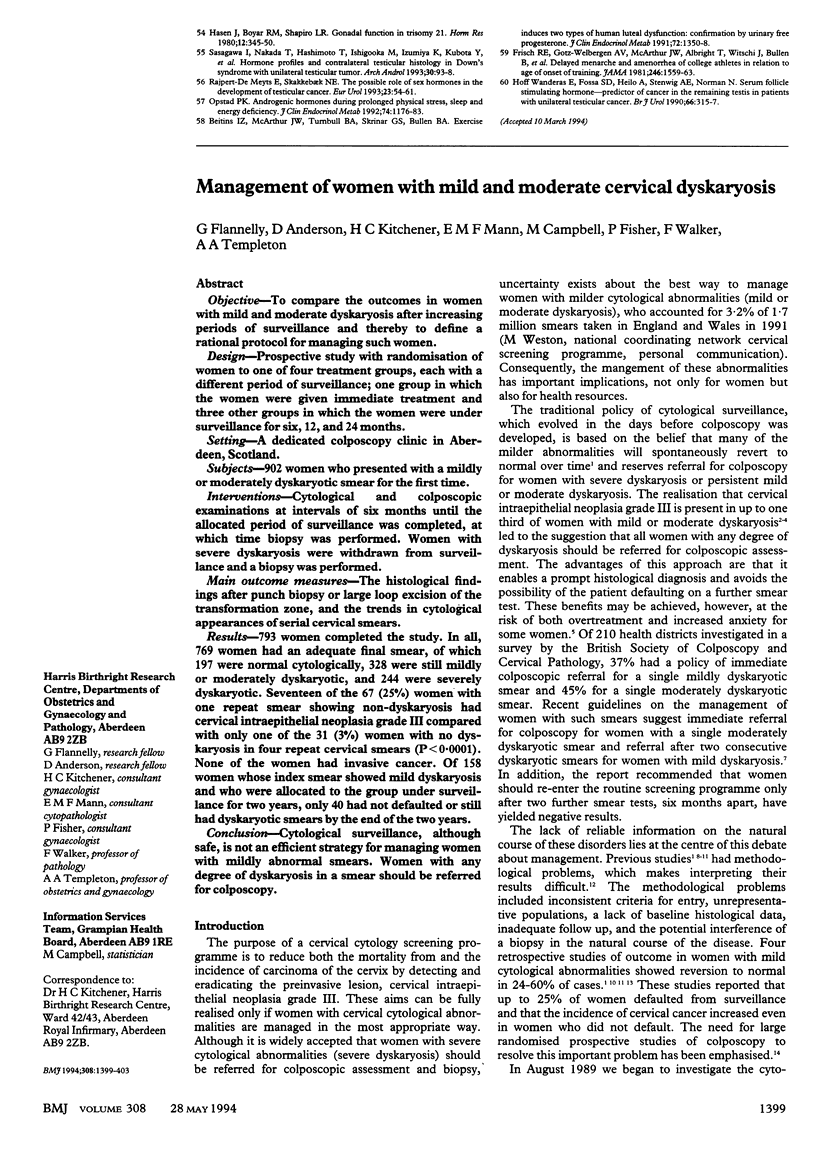
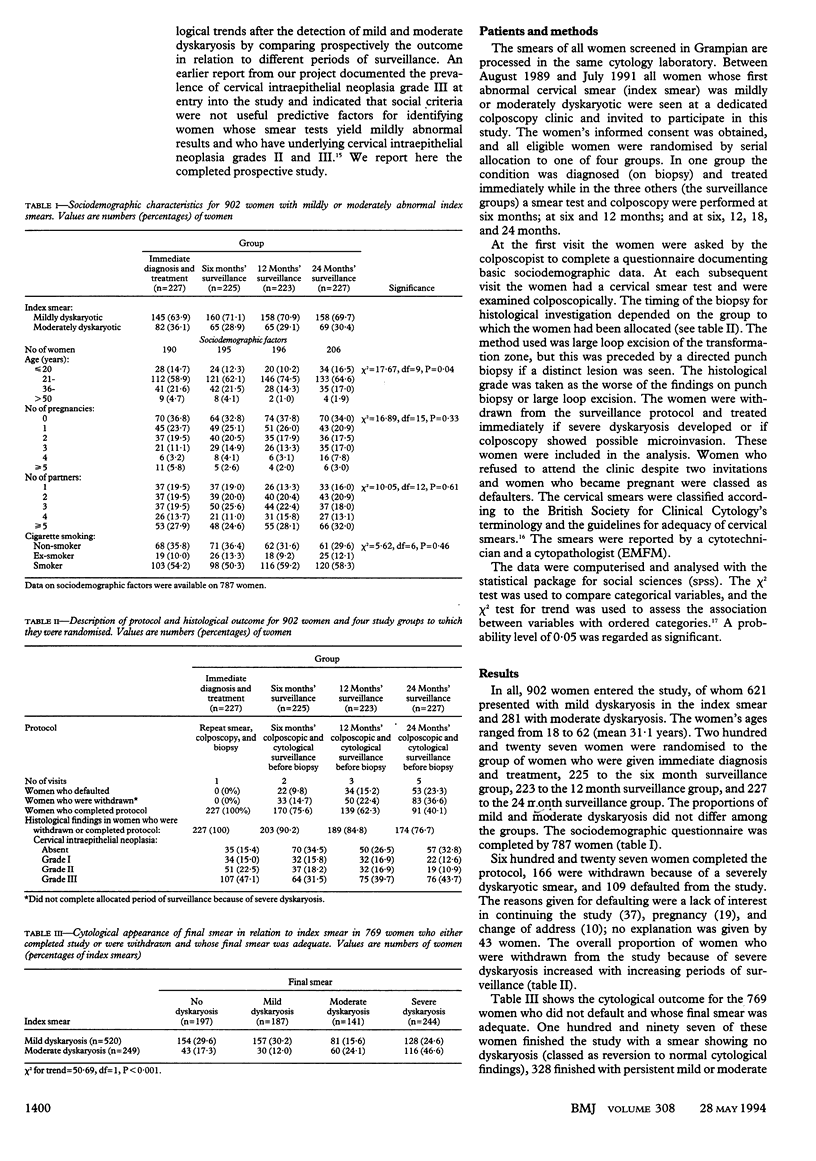
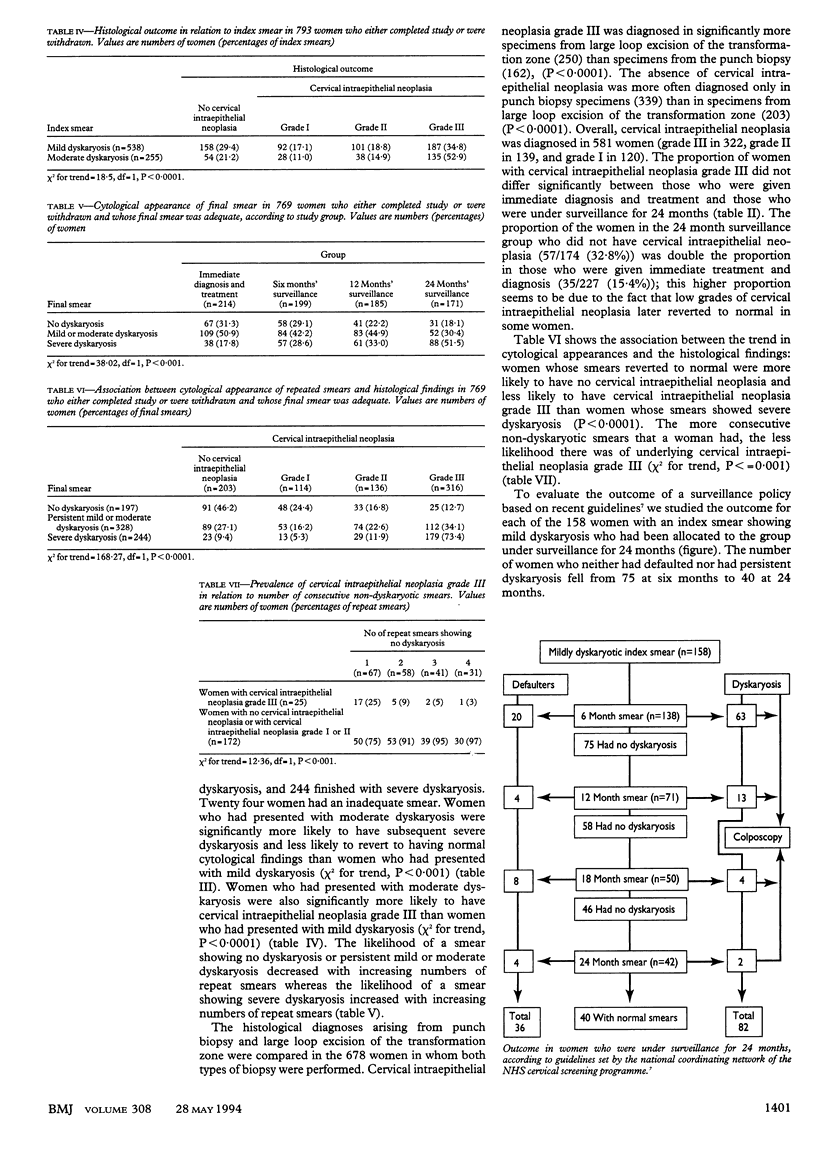
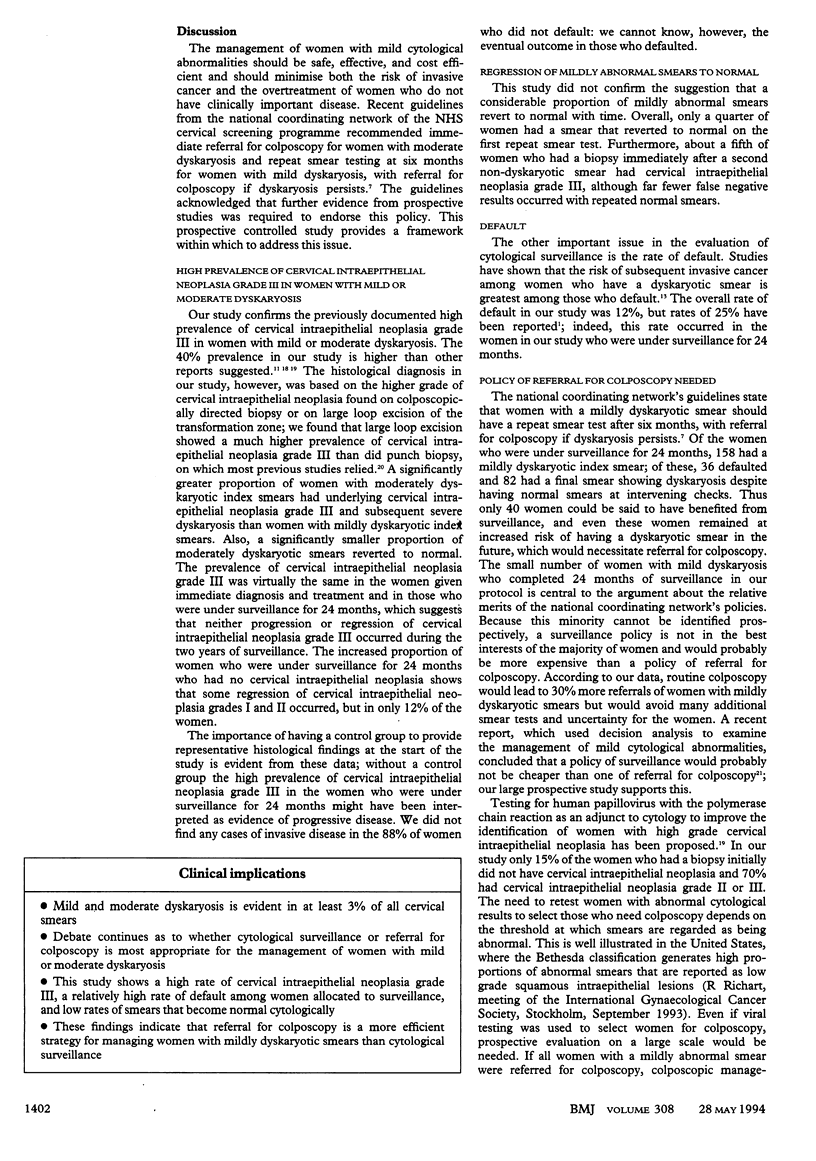
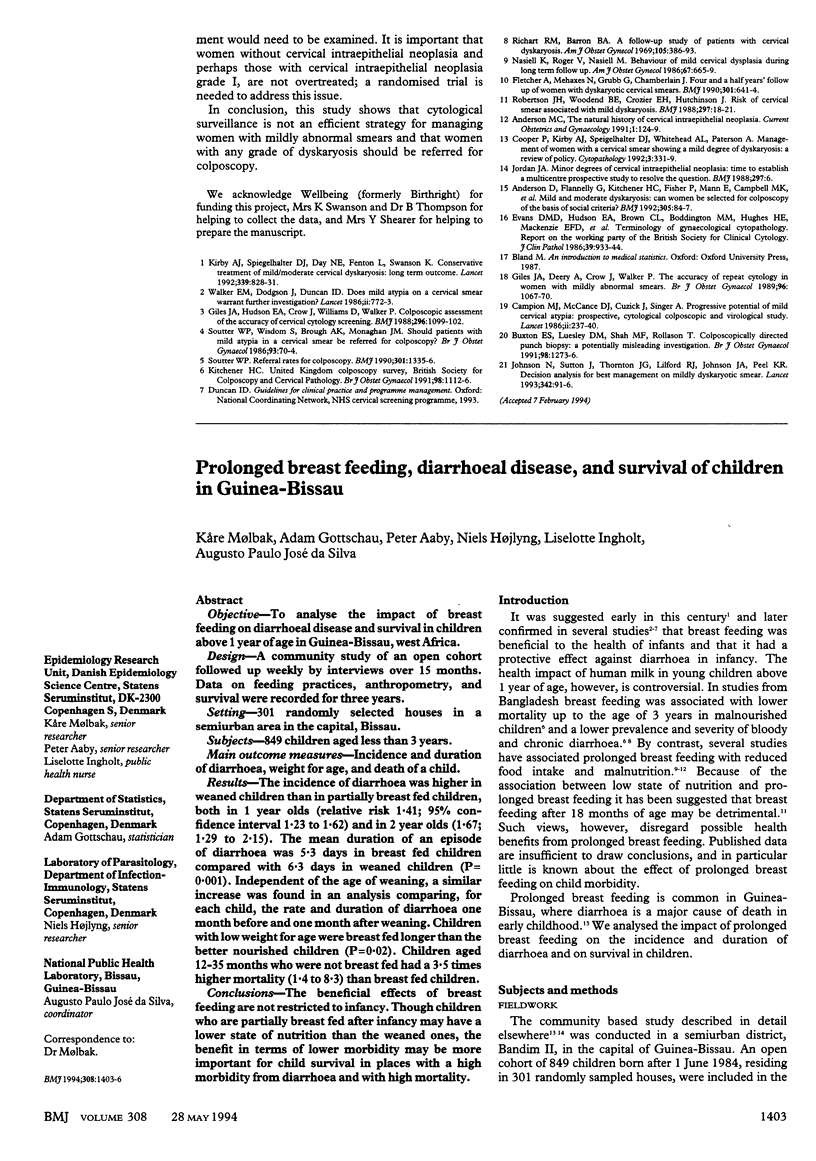
Selected References
These references are in PubMed. This may not be the complete list of references from this article.
- Anderson D. J., Flannelly G. M., Kitchener H. C., Fisher P. M., Mann E. M., Campbell M. K., Templeton A. Mild and moderate dyskaryosis: can women be selected for colposcopy on the basis of social criteria? BMJ. 1992 Jul 11;305(6845):84–87. doi: 10.1136/bmj.305.6845.84. [DOI] [PMC free article] [PubMed] [Google Scholar]
- Buxton E. J., Luesley D. M., Shafi M. I., Rollason M. Colposcopically directed punch biopsy: a potentially misleading investigation. Br J Obstet Gynaecol. 1991 Dec;98(12):1273–1276. doi: 10.1111/j.1471-0528.1991.tb15401.x. [DOI] [PubMed] [Google Scholar]
- Campion M. J., McCance D. J., Cuzick J., Singer A. Progressive potential of mild cervical atypia: prospective cytological, colposcopic, and virological study. Lancet. 1986 Aug 2;2(8501):237–240. doi: 10.1016/s0140-6736(86)92067-2. [DOI] [PubMed] [Google Scholar]
- Cooper P., Kirby A. J., Spiegelhalter D. J., Whitehead A. L., Patterson A. Management of women with a cervical smear showing a mild degree of dyskaryosis: a review of policy. Cytopathology. 1992;3(6):331–339. doi: 10.1111/j.1365-2303.1992.tb00058.x. [DOI] [PubMed] [Google Scholar]
- Evans D. M., Hudson E. A., Brown C. L., Boddington M. M., Hughes H. E., Mackenzie E. F., Marshall T. Terminology in gynaecological cytopathology: report of the Working Party of the British Society for Clinical Cytology. J Clin Pathol. 1986 Sep;39(9):933–944. doi: 10.1136/jcp.39.9.933. [DOI] [PMC free article] [PubMed] [Google Scholar]
- Fletcher A., Metaxas N., Grubb C., Chamberlain J. Four and a half year follow up of women with dyskaryotic cervical smears. BMJ. 1990 Sep 29;301(6753):641–644. doi: 10.1136/bmj.301.6753.641. [DOI] [PMC free article] [PubMed] [Google Scholar]
- Giles J. A., Deery A., Crow J., Walker P. The accuracy of repeat cytology in women with mildly dyskaryotic smears. Br J Obstet Gynaecol. 1989 Sep;96(9):1067–1070. doi: 10.1111/j.1471-0528.1989.tb03382.x. [DOI] [PubMed] [Google Scholar]
- Giles J. A., Hudson E., Crow J., Williams D., Walker P. Colposcopic assessment of the accuracy of cervical cytology screening. Br Med J (Clin Res Ed) 1988 Apr 16;296(6629):1099–1102. doi: 10.1136/bmj.296.6629.1099. [DOI] [PMC free article] [PubMed] [Google Scholar]
- Golding J., Thomas P., Peters T. Does father's unemployment put the fetus at risk? Br J Obstet Gynaecol. 1986 Jul;93(7):704–710. [PubMed] [Google Scholar]
- Johnson N., Sutton J., Thornton J. G., Lilford R. J., Johnson V. A., Peel K. R. Decision analysis for best management of mildly dyskaryotic smear. Lancet. 1993 Jul 10;342(8863):91–96. doi: 10.1016/0140-6736(93)91290-3. [DOI] [PubMed] [Google Scholar]
- Jordan J. A. Minor degrees of cervical intraepithelial neoplasia. BMJ. 1988 Jul 2;297(6640):6–6. doi: 10.1136/bmj.297.6640.6. [DOI] [PMC free article] [PubMed] [Google Scholar]
- Kirby A. J., Spiegelhalter D. J., Day N. E., Fenton L., Swanson K., Mann E. M., Macgregor J. E. Conservative treatment of mild/moderate cervical dyskaryosis: long-term outcome. Lancet. 1992 Apr 4;339(8797):828–831. doi: 10.1016/0140-6736(92)90278-b. [DOI] [PubMed] [Google Scholar]
- Nasiell K., Roger V., Nasiell M. Behavior of mild cervical dysplasia during long-term follow-up. Obstet Gynecol. 1986 May;67(5):665–669. doi: 10.1097/00006250-198605000-00012. [DOI] [PubMed] [Google Scholar]
- Richart R. M., Barron B. A. A follow-up study of patients with cervical dysplasia. Am J Obstet Gynecol. 1969 Oct 1;105(3):386–393. doi: 10.1016/0002-9378(69)90268-3. [DOI] [PubMed] [Google Scholar]
- Robertson J. H., Woodend B. E., Crozier E. H., Hutchinson J. Risk of cervical cancer associated with mild dyskaryosis. BMJ. 1988 Jul 2;297(6640):18–21. doi: 10.1136/bmj.297.6640.18. [DOI] [PMC free article] [PubMed] [Google Scholar]
- Soutter W. P. Referral rates for colposcopy. BMJ. 1990 Dec 8;301(6764):1335–1336. doi: 10.1136/bmj.301.6764.1335-c. [DOI] [PMC free article] [PubMed] [Google Scholar]
- Taylor R. M., Farrow B. R., Stewart G. J., Healy P. J. Enzyme replacement in nervous tissue after allogeneic bone-marrow transplantation for fucosidosis in dogs. Lancet. 1986 Oct 4;2(8510):772–774. doi: 10.1016/s0140-6736(86)90299-0. [DOI] [PubMed] [Google Scholar]


